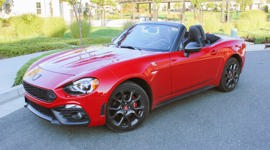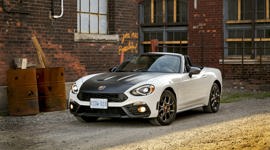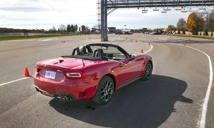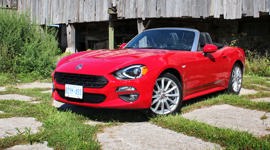Sitting behind the wheel of the new Fiat 124 Spider while blasting along one of the twisting canyon roads surrounding San Diego, California, one thing becomes crystal clear: All the comparisons to the Mazda MX-5 are somewhat beside the point, because whatever else it is or isn't, the Fiat 124 Spider is every bit as direct and fun to drive as its Mazda-flavoured cousin, and my grin is so wide it's hurting my lips. (Or perhaps that's just incipient sunburn because I'm in a convertible in California and I forgot to put on any lip balm?)
The more I see of the 124 Spider – especially in the flesh – the more I like it.
Still, while comparisons to the MX-5 may be somewhat beside the point they're not exactly unfair. Indeed they're inevitable, because the 124 Spider is based on the same platform as the MX-5, and the little Mazda roadster is a bit of a legend among enthusiast drivers. So while the initial reaction from Fiat fans at the 124 Spider's return is generally one of delight, the initial reaction from MX-5 fans hasn't been as universally thrilled (our Brendan McAleer called the 124's styling "marinara sauce poured over a delicately crafted sushi roll" in his story on the 124's initial debut).
I myself have a soft spot both for the original Fiat 124 Spider and for the Mazda MX-5, the latest generation of which I tested in December 2015. I'll admit that while I liked the new Fiat from the get-go, I was initially a little disappointed that it had lost some of the delicacy of its predecessor's looks. But here's the thing about good design: It grows on you. And the more I see of the 124 Spider – especially in the flesh – the more I like it.
The new 124 was designed by Centro Stile in Turin, Italy and doesn't share any sheetmetal at all with the MX-5. It's a little longer (140 mm) and a fraction wider (5 mm) than the MX-5, with just over half the extra length at the front to accommodate Fiat's slightly larger engine, and the remainder at the back, giving the Fiat a longer deck reminiscent of the original 124, and a slightly larger trunk (140L versus 130L in the MX-5).
Even to a casual observer, the new 124 manages to recall the original without slavishly copying it. Up front, there's an expressive fascia with a trapezoidal grille, just like in the original, and it has the same distinctive character line running from the front fenders and kicking up over the door handle to emphasize the rear haunches. Modern stylistic touches include a twin power domes on the hood and LED character lighting front and rear (the rear lights also feature body-coloured central inserts that give them a ring-like effect). Overall, the 124 Spider's bodywork may not have the MX-5's shrink-wrapped minimalism, but it does have a certain rightness to its proportions. From the front it also has a slight resemblance to the BMW Z8, a car that surely must count as one of the world's most beautiful yet unattainable roadsters.
Inside, it must be admitted, the 124 is virtually indistinguishable from the Mazda MX-5. At the pre-drive presentation the designers spoke about its reconfigured seat structure and additional soft-touch materials, and the Lusso model I drove for the first part of the day did have a lovely stitched leather dash insert, but aboard the 124 Spider Classico I could see little beyond the steering wheel badge to differentiate between it and an MX-5 GX: There's the same big, clear and easy-to-read gauges (except in the Abarth, which gets a red-faced tachometer), the same awkwardly placed but moveable cupholders, the same lockable cubby between the seats in lieu of a glovebox, the same easy-to-operate soft top, the same Mazda-sourced infotainment system, and the same fits-like-a-glove seating.
At 5'11" and 165 pounds I found the driver's seat to be a perfect fit, while the slightly smaller space on the passenger's side had me carefully adjusting the seat to provide a balance of leg room and space to recline the seatback. My driving partner was 6'4" with much of his height in the torso, and he fit surprising well in the driver's seat when the roof was stowed, but had to slouch down when the roof was up. On the other hand, he didn't have to shout to make himself heard, because the extra soundproofing in the 124 Spider means it's significantly quieter than the MX-5. You can carry on a normal conversation at 110 km/h whether the top is up or down, and with the top up it's downright quiet, certainly by convertible standards.
Under the hood, instead of Mazda's 2.0L SkyActiv four-cylinder (an engine that's good for 155 hp and 148 lb-ft of torque) the Fiat 124 gets the same turbocharged 1.4L Multiair four-cylinder engine as used in the Fiat 500 Abarth. In the 124 Spider Classico and Lusso trims, the engine is tuned to crank out 160 hp and 184 lb-ft of torque (in the 500 Abarth it nets 160 hp and 170 lb-ft of torque), and in the 124 Spider Abarth it's pushed even further to add an extra four horsepower, for a total of 164 hp.
It's a real cracker of an engine and quintessentially Italian, with lots of torque down low, a nice exhaust note, and an eager, free-revving character when driven with verve. For the 124 Spider it can be hooked up to either a Mazda-sourced six-speed manual transmission (not the same as the MX-5's apparently, but one more suited to the higher torque produced by the turbocharged motor) or a Fiat/Chrysler-sourced Aisin six-speed automatic, as used in the Fiat 500L.
On the road, I was hoping that the engine would have the same eager-puppy friskiness evident in the 500 Abarth, but the 124's exhaust has been tuned for a more refined experience, so you don't get the same snap-crackle-pop that you get in the 500 Abarth. In manual-transmission cars you do get a little bit of a rorty double-blat whenever you shift, but the automatic-equipped cars are quite subdued sounding, with more of a gentle burble than anything else. Abarth-trimmed cars get a retuned exhaust that delivers more auditory gusto to go with the extra four horsepower, and for my sensibilities it's the setup I like best.
The Abarth-trim cars also get a Sport button that sharpens the throttle and steering responses and, for cars equipped with the automatic, remaps the transmission shift points. Here I think Fiat is doing buyers of automatic-equipped cars a disservice, because Sport mode transmission mapping ought to be available in all trims. I found that in real-world driving the automatic was far too keen to upshift for fuel economy, so when I got onto an entertaining road I was pretty much forced to use the console-operated manual shifting function if I wanted to keep the fun on tap. It's understandable that with only a four-horsepower difference between the engines Fiat would want to save the sport button to help differentiate the Abarth, but it already gets paddle shifters where the Classico and Lusso don't, and the sport mode should be standard across the range just like it is in the Fiat 500.
In terms of the driving experience, the Fiat 124 Spider carries an extra 53 kg compared to the Mazda MX-5, most of this up front due to the slightly heavier engine (the remainder is in things like extra insulation and acoustic glass, added to give the 124 Spider a slightly more refined feel). Thanks to the Fiat's increased power over the MX-5, acceleration is about the same between the two cars despite the 124 Spider's extra heft, at about 6 seconds 0-100 km/h (maybe even a little quicker in the 124). Fuel economy is likewise expected to come in about the same as the MX-5 at up to 6.5 L/100 km on the highway (I saw 10.4 L/100 km in mixed driving behind the wheel of the manual-equipped car, and 9.0 L/100 km in the automatic).
The 124's additional weight does bump the front/rear weight distribution from 53/47 in the MX-5 to 54/46 in the 124, but that slight difference isn't something you particularly notice on the road. What is noticeable is that although the 124 Spider has the same double-wishbone front and multilink rear suspension setup as the MX-5, the Classico and Lusso versions have slightly more supple suspension tuning. This definitely reduces the amount of jostling you get in the cockpit, but didn't seem to work against the car during my hard-charging canyon driving – the 124 is an absolute delight in the corners, with precise steering and great balance.
Later we had an opportunity to sling some Abarth-trimmed cars around a high-speed autocross course, and with their upgraded Bilstein suspensions they certainly had the same directly connected feel as the MX-5 and the same ability to truly sense (and use) the rotation of the car if you choose to drive with the stability control off.
Price- and trim-wise, the Fiat 124 Spider starts at $33,495 for the Classico, which gets 16-inch aluminum wheels, manual air conditioning, cloth seats, leather-wrapped steering wheel, remote keyless entry, pushbutton start, six-speaker AM/FM/MP3 audio system, dual stainless exhaust, halogen headlamps, LED taillights, manual soft top with aluminum header, and body-coloured windshield surround. The Lusso starts at $36,495 and adds 17-inch alloys, front fog lamps, automatic headlights, rain sensing wipers, silver-finished windshield surround and roll bar, chromed exhaust tips, leather-faced heated seats, wrapped cluster brow, Fiat Connect 7-inch touchscreen media centre, automatic climate control, keyless proximity entry and backup camera. The Abarth starts at $37,995 and adds an extra four horsepower, mechanical limited-slip differential, sport-tuned quad-tipped exhaust, paddle shifters with automatic transmission, sport mode, Bilstein shock absorbers, front strut tower, heated microfibre faced seats, aluminum-accent pedals, black side sills, Abarth badging, gunmetal grey alloys, and more aggressive-looking front and rear fascias that recall the bumperless look of the original 124 Abarth.
For my money I prefer the classic look of the Lusso, with its silver windshield surround, friendly front fascia and bright wheels, but I'd prefer to have it with the sport-tuned engine, exhaust, and suspension of the Abarth – a bit of a sleeper, if you will. I mentioned this to Fiat North America's Senior Manager of Product Marketing Rafael Paz, and he seemed warm to the idea, so perhaps that's something we'll be able to order in the future. In the meantime, to celebrate the car's Canadian launch later this summer, and to commemorate the model's 50th anniversary (the original 124 debuted in 1966), Fiat will offer a $42,190 limited edition Prima Edizione version finished in the same Bronzo Magnetico paint and Saddle Brown leather upholstery as the Lusso edition that I drove during the first half of the drive event, and loaded with all the bells and whistles including automatic transmission, Bose premium audio system, XM radio, satellite navigation, headlamp washers and much more. Whichever way you order it up, however, the Fiat 124 Spider delivers genuine Italian soul in an affordable two-seat roadster package. What's not to love about that?
Pricing: 2017 Fiat 124 Spider
Spider Classica: $33,495
Spider Lusso: $36,495
Spider Abarth: $37,995
Prima Edizione: $42,190


























































